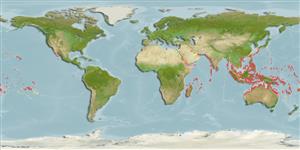Common names from other countries
Classification / Names / Names
Populärnamn | synonymer | Catalog of Fishes (gen., sp.) | ITIS | CoL | WoRMS
Environment: milieu / climate zone / depth range / distribution range
Ekologi
Revassocierade; djupintervall 3 - 20 m (Ref. 98471). Tropical; 35°N - 30°S, 32°E - 108°W (Ref. 846)
Indo-Pacific. Tropical to subtropical.
Length at first maturity / Size / Vikt / Age
Maturity: Lm ? range ? - ? cm
Most reef habitats except turbid water (Ref. 846). Carries dense populations of the bivalve L. simplex. Bivalves are completely enclosed by the skeleton. They benefit from the coral through nutrition and protection against predators. The coral's gain, however, is unclear (Ref. 115168).
Life cycle and mating behavior
Könsmognad | Reproduktion | Lek | Ägg | Fecundity | Larver
Hermaphroditic (Refs. 113708, 113712). Mature gametes are shed into the coelenteron and spawned through the mouth. Life cycle: The zygote develops into a planktonic planula larva. Metamorphosis begins with early morphogenesis of tentacles, septa and pharynx before larval settlement on the aboral end (Ref. 833).
Veron, J.E.N. 2000. (Ref. 846)
IUCN Red List Status (Ref. 130435)
CITES status (Ref. 108899)
Not Evaluated
Human uses
| FishSource |
Verktyg
Ytterligare information
Age/SizeTillväxtLength-weightLength-lengthMorfologiLarverAbundans
Internet-källor
Estimates based on models
Preferred temperature
(Ref.
115969): 25 - 29.3, mean 28.4 (based on 3492 cells).
Price category
Unknown.
